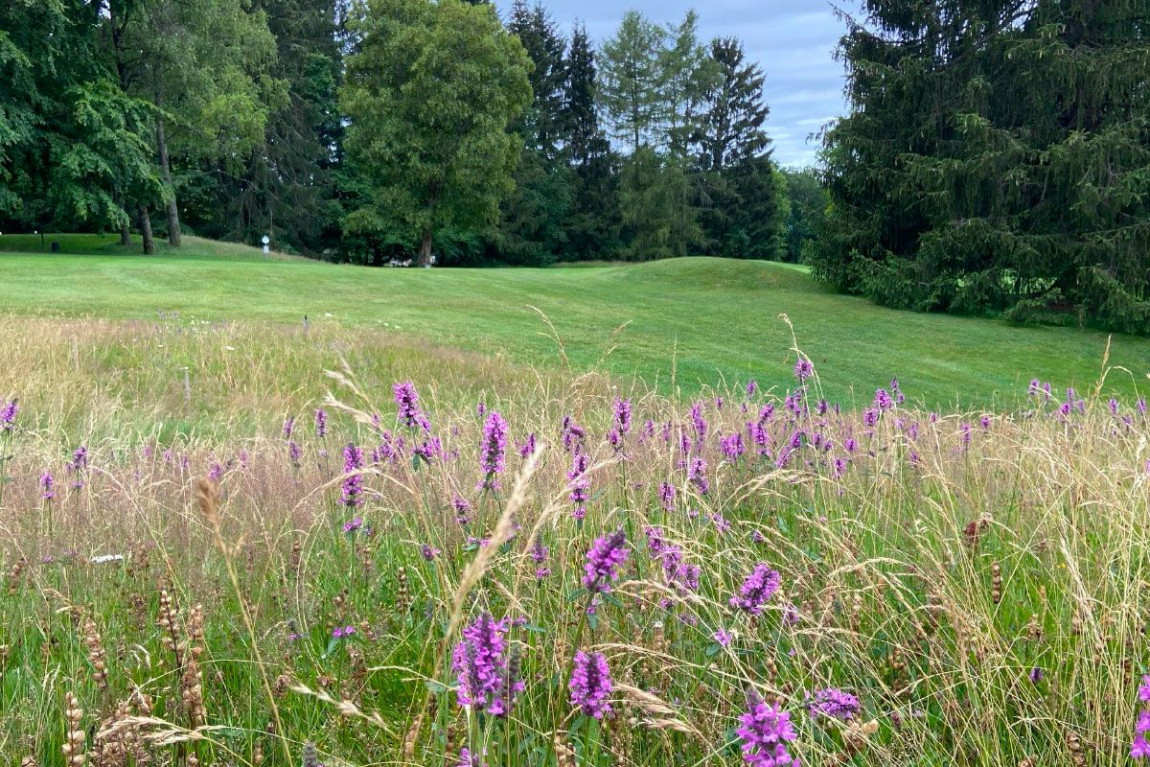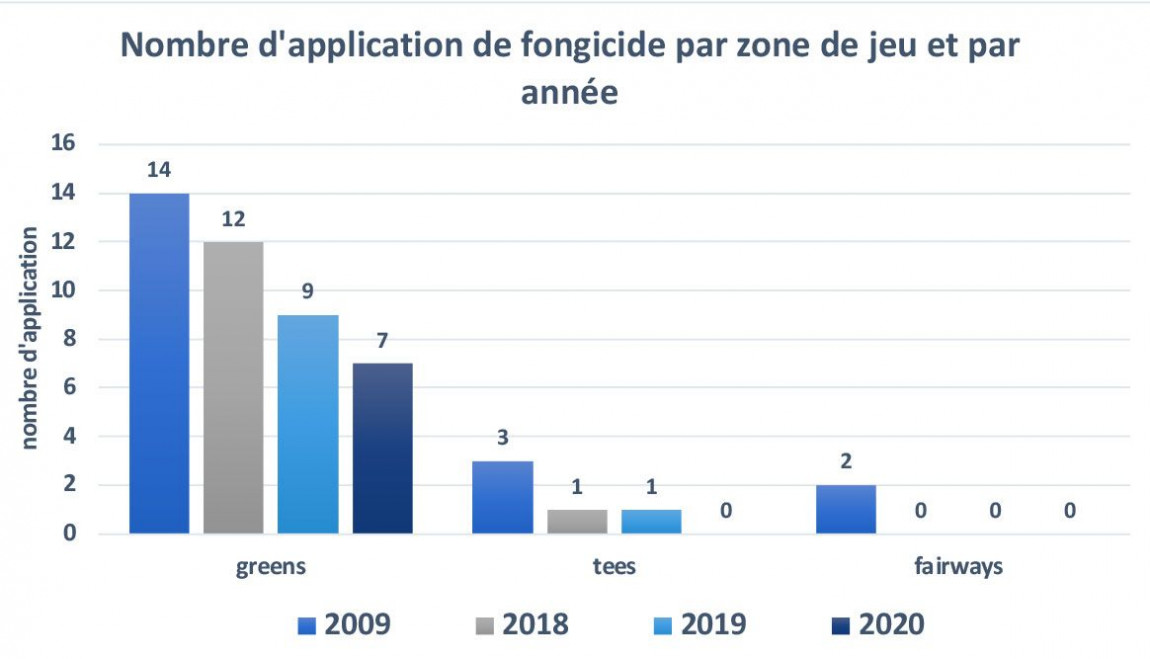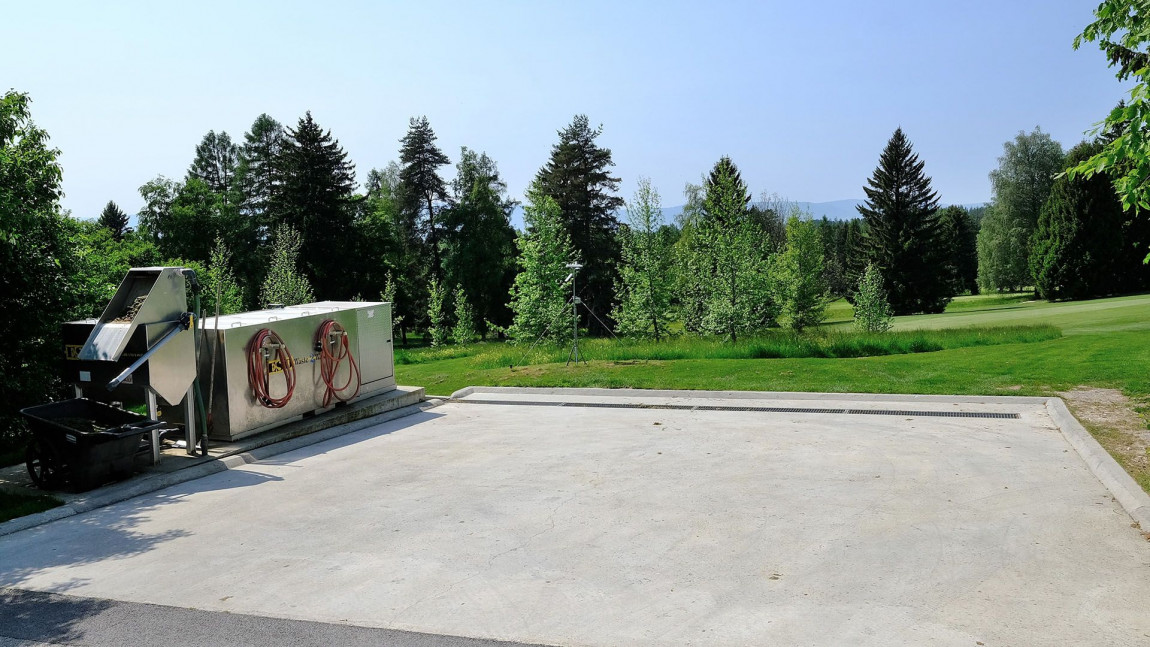Treatments & products
The Golf Club de Lausanne pays close attention to the products and inputs used to manage its grounds, with the clear objective of being completely pesticide-free by 2030 at the latest, in line with Swiss Golf strategy. Waste management and recycling are also critical issues.
Products and inputs on the course
The total surface area of the Golf Club de Lausanne is around 50 hectares (49.2 hectares spread over the communes of Lausanne and Epalinges), with around 25 hectares of grassed surface, 15 of which are irrigated, distributed as follows:
- Greens: 1.2 hectares (1.2 hectares of irrigated area)
- Tees: 0.6 hectares (0.6 hectares of irrigated area)
- Fairways: 8 hectares (8 hectares of irrigated area)
- Semi-roughs and roughs: 13.4 hectares (but only 3 hectares of irrigated area)
- Practice area: 1.6 hectares (1.6 hectares irrigated, but only in very hot weather)
Native natural grassland or flower meadows cover an area of 5 hectares. These meadows play an important role in protecting the flora and fauna.
Groves, hedgerows, thorny hedges and strips of woodland contain a wide variety of plants likely to be home to many species of birds, insects, small mammals, bats, etc.
The Integrated Pest Management (IPM) approach to greenkeeping generally keeps chemical inputs to a minimum, with most restricted to the greens. Splitting the fertilisation programme on the greens minimises the risk of overdosing and possible leaching into groundwater.
Reducing the use of crop protection products, particularly fungicides, is the basis of our conversion from bluegrass to bentgrass.
Currently, only 1.2 hectares of greens out of a total surface area of 49.2 hectares, or 2.44% of the golf course's total area, are treated with fungicides. In 2020, we applied 7 fungicide treatments; in 2021, also 7 treatments and, in 2022, we applied only 5. A decade ago, we were doing between 12 and 16 fungicide treatments a year. Over the next few years, the target for greens is to further reduce the number of fungicide treatments from 3 to 6 per year.
For this conversion to be successful, it requires the felling and thinning of trees that shade the greens. As part of our woodland management plan, we have scheduled the replacement of 42 trees around the greens and we intend to replant a total of more than 2,000 native trees and shrubs. This is the first step towards achieving our common goal.
On the greens in particular, we continue to seek for effective alternatives to the use of agrochemical products. Our strategy is to develop and strengthen the implementation of Integrated Pest Management (IPM).
The fundamental principle of IPM in turf management is to manage it well so that it is healthy and has a good capacity to resist and recover from environmental stress or pest pressure.
The main control methods are as follows :
- Select appropriate species and cultivars.
- Avoid high speed greens for everyday play, and opt for speeds of between 2.6 m and 2.9 m (8.5 to 9.5 feet), while ensuring that the ball does not bounce.
- Irrigation: a properly irrigated lawn is more resistant to various stresses such as disease and insects.
- Soil fertility and pH: fertilisation is an integral part of turf management.
- Thatch management: There are a number of management practices that can be used to reduce thatch build-up. For greens, regular sanding is the best method, and ensures better planimetry, which is essential for the game of golf.
- Soil management: improving the rooting zone can have a very positive impact on the health of the turf and, at the same time, reduce the need for pesticides. Good drainage is essential for root growth and the overall health of the turf.
- Silviculture: trees play a strategic role in the design and construction of a golf course and are an important aesthetic asset. However, their location needs to be carefully considered, and the cultivation methods in shaded areas must be adapted.
- Alternative control methods: bio stimulants and other products that stimulate the plant's natural defences (NDS).
- Chemical treatment: to be used as a last resort and on greens only.
For almost 10 years, the Golf Club de Lausanne has been working with the STRI (Sport Turf Research Institute) to introduce new techniques in sports ground maintenance and remains in close contact with other French, Danish and British greenkeepers' associations to study the solutions already in place or planned for the future. From a technical point of view, this means challenging our teams, and ongoing training will help us to see this change of direction in a positive light.
There is currently no miracle product on the market to replace fungicides. Several alternative products exist on the market, based on bacteria, natural defence stimulants, bio stimulants, etc., but there are no serious scientific studies to back up these results.
The fairways are fertilised with organic fertiliser. Since 2019, no fungicides have been applied to these playing areas. The policy adopted for herbicide treatments, mainly for the continued development of clover, is to carry out localised treatments only.
Where possible, insecticides are no longer used so as to encourage earthworms to work in the soil, which they aerate by digging tunnels that also improve water infiltration and drainage. What's more, earthworms break down dead plant matter into valuable humus that can be used by plants. The only problem is their droppings, the negative effect of which is mitigated by sanding in spring and autumn.
Similarly, the chemical fertilisers used on the semi-roughs have been replaced by organo-mineral fertilisers.
Lastly, no fertiliser is applied to the roughs, except in the heavily trafficked areas where the turf needs to be reinforced.
Washing station
Since 2020, the Golf Club de Lausanne has had a new machine washing station with recovery/filtration of oils and other pollutants. This sustainability measure is considered by a Swiss Golf study to have a significant impact on the overall environmental impact of a golf course.
Waste management
As part of our sustainability efforts, we are currently analysing our various recycling processes, with the help of Swiss Recycling, to identify areas for improvement.






